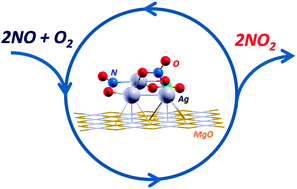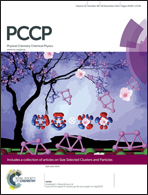Ligand/cluster/support catalytic complexes in heterogeneous ultrananocatalysis: NO oxidation on Ag3/MgO(100)
Abstract
In the present work we explore via first-principles simulations whether the ligand/cluster/support catalytic complex generated by CO oxidation over silver trimers deposited on the regular MgO(100) surface – i.e. a Ag3/carbonate or Ag3(CO3)/MgO(100) species – can be used as a catalyst in a different reaction: the selective oxidation of NO to NO2 (or NOox). The Ag3(CO3)/MgO(100) complex is first shown to be reasonably stable at room temperature in terms of both disaggregation and sintering, and that it can be generated from Ag3 adsorbed onto an oxygen vacancy defect of the regular MgO(100) surface under oxidation conditions. It is then found that the Ag3(CO3)/MgO(100) species transforms under NOox conditions into an even more complex aggregate, a mixed carbonate/double-nitrite Ag3(CO3)(NO2)2/MgO(100) species, which can then act as an efficient catalyst of NOox. It is noteworthy that under NOox reaction conditions a different ligand/cluster/support catalytic complex is formed with respect to the original COox one. These findings prove the diversity of the catalytic chemistry of subnanometer (or ultranano) metal clusters deposited on oxide substrates, associated with the formation of many different ligand/cluster/support aggregates, the vast amount of combinatorial possibilities thus opening, and the need for computational approaches to perform systematic structural and stoichiometric searches in order to cope with such a multiform diversity.

- This article is part of the themed collection: Size Selected Clusters and Particles: From Physical Chemistry to Catalysis

 Please wait while we load your content...
Please wait while we load your content...